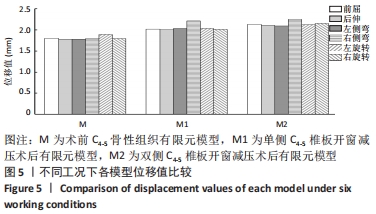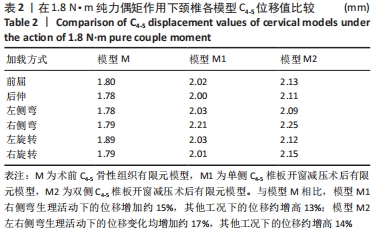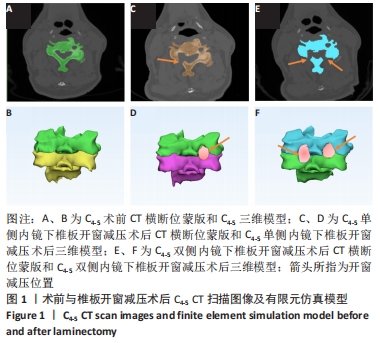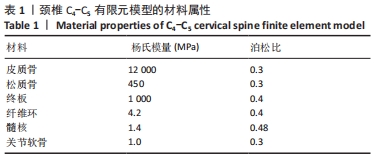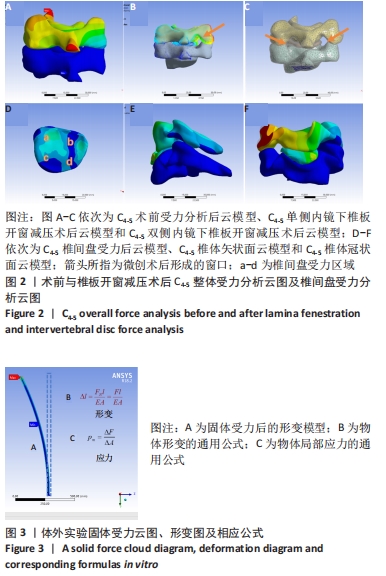[1] 杨宝林,张绍东,王小虎,等.颈椎后路改良单开门椎管扩大成形术治疗多节段脊髓型颈椎病的疗效分析[J]. 中国脊柱脊髓杂志, 2018,28(4):289-296.
[2] NASTO LA, MUQUIT S, PEREZ-ROMERA AB, et al. Clinical outcome and safety study of a newly developed instrumented French-door cervical laminoplasty technique. J Orthop Traumatol. 2017;18(2):135-143.
[3] LI Z, LIU H, YANG M, et al. A biomechanical analysis of four anterior cervical techniques to treating multilevel cervical spondylotic myelopathy: a finite element study. BMC Musculoskelet Disord. 2021; 22(1):278.
[4] FENG S, ZHENG B, ZHANG L, et al. A systematic review and meta-analysis compare surgical treatment and conservative treatment in patients with cervical spondylotic myelopathy. Ann Palliat Med. 2021;10(7):7671-7680.
[5] 刘金玉,崔洪鹏,丁宇,等.椎间孔镜术后腰椎间盘突出复发与后纵韧带完整性关系的有限元生物力学研究[J].中国骨与关节杂志, 2021,10(7):508-514.
[6] OUYANG P, LI J, HE X, et al. Biomechanical Comparison of 1-Level Corpectomy and 2-Level Discectomy for Cervical Spondylotic Myelopathy: A Finite Element Analysis. Med Sci Monit. 2020;26: e919270.
[7] GUO Q, XU Y, FANG Z, et al. Clinical and Radiological Outcomes of Two Modified Open-door Laminoplasties Based on a Novel Paraspinal Approach for Treatment of Multilevel Cervical Spondylotic Myelopathy. Spine. 2022;47(6):E222-E232.
[8] 马壮.以岗位胜任力为核心的运动康复人才培养战略[J].经营与管理,2013(6):105-107.
[9] YANEZ TOUZET A, BHATTI A, DOHLE E, et al. Clinical outcome measures and their evidence base in degenerative cervical myelopathy: a systematic review to inform a core measurement set (AO Spine RECODE-DCM). BMJ Open. 2022;12(1):e57650.
[10] 陈钵,秦大平,张晓刚,等.有限元分析法在脊柱生物力学中的研究进展[J].中国疼痛医学杂志,2020,26(3):208-216.
[11] 吴超,王振宇,林国中,等.颈椎单侧半椎板及不同程度小关节切除术后生物力学变化的有限元分析[J]. 中华神经外科疾病研究杂志,2018,17(4):352-356.
[12] LI Q, HAN X, WANG R, et al. Clinical recovery after 5 level of posterior decompression spine surgeries in patients with cervical spondylotic myelopathy: A retrospective cohort study. Asian J Surg.2020;43(5):613-624.
[13] WANG Y, WANG L, DU C, et al. A comparative study on dynamic stiffness in typical finite element model and multi-body model of C6-C7 cervical spine segment. Int J Numer Method Biomed Eng. 2016;32(6):10.
[14] DENG Z, WANG K, WANG H, et al. A finite element study of traditional Chinese cervical manipulation. Eur Spine J. 2017;26(9):2308-2317.
[15] VOO LM, KUMARESAN S, YOGANANDAN N, et al. Finite element analysis of cervical facetectomy. Spine (Phila Pa 1976). 1997;22(9): 964-969.
[16] SEIPEL RC, PINTAR FA, YOGANANDAN N, et al. Biomechanics of calcaneal fractures: A model for the motor vehicle. Clin Orthop Relat Res. 2001;(388):218-224.
[17] ZHAO L, CHEN J, LIU J, et al. Biomechanical analysis on of anterior transpedicular screw-fixation after two-level cervical corpectomy using finite element method. Clin Biomech (Bristol, Avon). 2018;60:76-82.
[18] 刘金玉,丁宇,蒋强,等.全内镜下腰椎板开窗减压有限元模拟建模及生物力学变化[J].中国组织工程研究,2020,24(27):4291-4296.
[19] YUAN H, ZHANG X, ZHANG L, et al. Comparative study of curative effect of spinal endoscopic surgery and anterior cervical decompression for cervical spondylotic myelopathy. J Spine Surg. 2020;6(S1):S186-S196.
[20] WANG XZ, LIU H, LI J Q, et al. Comparison of Anterior Cervical Discectomy and Fusion with Cervical Laminectomy and Fusion in the Treatment of 4‐Level Cervical Spondylotic Myelopathy. Orthop Surg. 2022;14(2):229-237.
[21] TETREAULT L, KALSI-RYAN S, BENJAMIN D, et al. Degenerative Cervical Myelopathy: A Practical Approach to Diagnosis. Global Spine J. 2022: 1280955569.
[22] KIM HC, JEON H, JEONG YH, et al. Factors Affecting Postoperative Complications and Outcomes of Cervical Spondylotic Myelopathy with Cerebral Palsy : A Retrospective Analysis. J Korean Neurosurg Soc. 2021;64(5):808-817.
[23] YAO M, LI G, ZHOU L, et al. Shikonin inhibits neuronal apoptosis via regulating endoplasmic reticulum stress in the rat model of double-level chronic cervical cord compression. Cell Biol Toxicol. 2022. doi: 10.1007/s10565-021-09648-3.
[24] AKTER F, YU X, QIN X, et al. The Pathophysiology of Degenerative Cervical Myelopathy and the Physiology of Recovery Following Decompression. Front Neurosci. 2020;14:138.
[25] ZHANG M, OU-YANG H, LIU J, et al. Predicting postoperative recovery in cervical spondylotic myelopathy: construction and interpretation of T2*-weighted radiomic-based extra trees models. Eur Radiol. 2022. doi: 10.1007/s00330-021-08383-x.
[26] ZHONG W, WANG L, HUANG T, et al. Risk factors for rapid progressive neurological deterioration in patients with cervical spondylotic myelopathy. J Orthop Surg Res. 2021;16(1):75-75.
[27] 郑耀超,林彩娜,柯松坚,等.多裂肌核心稳定性训练:超声联合表面肌电监测与无监测的比较[J]. 中国组织工程研究,2018,22(36): 5785-5790.
[28] KIMURA A, ENDO T, INOUE H, et al. Impact of axial neck pain on quality of life after laminoplasty. Spine (Phila Pa 1976). 2015;40(24): E1292-E1298.
[29] PANJABI MM, CHOLEWICKI J, NIBU K, et al. Critical load of the human cervical spine: An in vitro experimental study. Clin Biomech (Bristol, Avon). 1998;13(1):11-17.
[30] ZIKA J, ALEXIOU GA, GIANNOPOULOS S, et al. Outcome factors in surgically treated patients for cervical spondylotic myelopathy. J Spinal Cord Med. 2020;43(2):206-210.
[31] HIRABAYASHI S, KITAGAWA T, YAMAMOTO I, et al. Development and achievement of cervical laminoplasty and related studies on cervical myelopathy. Spine Surg Relat Res. 2019;4(1):8-17.
[32] SCHOMACHER J, FALLA D. Function and structure of the deep cervical extensor muscles in patients with neck pain. Man Ther. 2013;18(5): 360-366.
[33] PILATO F, CALANDRELLI R, DISTEFANO M, et al. Multidimensional assessment of cervical spondylotic myelopathy patients. Usefulness of a comprehensive score system. Neurol Sci. 2021;42(4):1507-1514.
[34] CHENG CH, CHIEN A, HSU WL, et al. Investigation of the differential contributions of superficial and deep muscles on cervical spinal loads with changing head postures. PLoS One. 2016;11(3):e0150608.
[35] DAVIES BM, MOWFORTH O, WOOD H, et al. Improving Awareness Could Transform Outcomes in Degenerative Cervical Myelopathy [AO Spine RECODE-DCM Research Priority Number 1]. Global Spine J. 2022;12(1):28S-38S.
[36] XU C, WANG R, LI J, et al. Intervertebral-spreader-assisted anterior cervical discectomy and fusion prevents postoperative axial pain by alleviating facet joint pressure. J Orthop Surg Res. 2022;17(1):91.
[37] JIANG Q, DING Y, LU Z, et al. Comparative analysis of non-full and full endoscopic spine technique via Interlaminar approach for the treatment of degenerative lumbar spinal stenosis: A retrospective, single Institute, propensity score-matched study. Global Spine J. 2021; 18(5):360-366.
[38] RYU WHA, PLATT A, DEUTSCH H. Hybrid decompression and reconstruction technique for cervical spondylotic myelopathy: case series and review of the literature. J Spine Surg. 2020;6(1):181-195.
[39] DUAN Y, WANG HH, JIN AM, et al. Finite element analysis of posterior cervical fixation. Orthop Traumatol Surg Res. 2015;101(1):23-29.
[40] 刘金玉,丁逸苇,卢正操,等.有限元分析全可视化内镜下椎板开窗减压治疗脊髓型颈椎病的生物力学特点[J].中国组织工程研究, 2021,25(24):3850-3854.
[41] LU X, ZOU F, LU F, et al. How to reconstruct the lordosis of cervical spine in patients with Hirayama disease? A finite element analysis of biomechanical changes focusing on adjacent segments after anterior cervical discectomy and fusion. J Orthop Surg Res. 2022;17(1):101.
[42] 樊瑜波,邓小燕.生物力学建模仿真与应用[M].上海:上海交通大学出版社,2017:1-5.
[43] 钱伟长,叶开沅.弹性力学[M].北京:科学出版社,1956:69-102.
|


